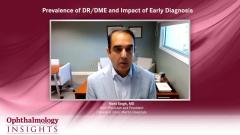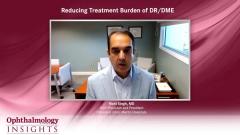
Symptoms of DR/DME and Recommendations
Carolyn Majcher, OD, FAAO, provides an overview of the symptoms of diabetic retinopathy and diabetic macular edema (DR/DME) and recommendations for dilated eye exams for patients with type 1 and type 2 diabetes.
Episodes in this series

Rishi Singh, MD: Let me ask you a few questions if you might, Dr Majcher, about sort of how patients with diabetic macular edema or diabetic retinopathy are in clinic. You are a teacher, as you mentioned in your biography, and I wonder, are your students as adept at picking up what those signs and symptoms might be of that patient walking in the door?
Carolyn Majcher, OD, FAAO: Yeah, the students do a really wonderful job. But regarding symptoms, unfortunately most patients with diabetic retinopathy are asymptomatic, and therefore have no impact on their quality of life until they reach that moderate non-proliferative stage of retinopathy. Like you were saying earlier, it's a silent type of disease. This lack of symptoms makes the early diagnosis and detection of retinopathy sometimes very challenging and difficult for us.
In some cases, patients may even have vision-threatening complications such as high-risk proliferation or anterior segment neovascularization with good, even 20/20, acuity vision. Additionally, patients may not even be aware that they have type 2 diabetes. We're the primary eye care providers, and they may just come to us with myopic refractive shift, or we coincidentally find retinopathy during a routine examination, which then prompts us to say you need to go visit your primary care provider so we can check the A1C, check your blood glucose, to see if they have diabetes.
When patients do develop symptoms, they tend to complain of gradual painless vision decline in both eyes, or perhaps fluctuating vision, sometimes their glasses work, sometimes they don't. Acute onset monocular vision loss or increased floaters is usually the result of a new vitreous hemorrhage or preretinal hemorrhage, and the most common cause of vision loss we know is diabetic macular edema. And that can occur at any stage of diabetic retinopathy, so we always have to keep an eye out for it. However, patients with macular ischemia or what we define as an enlargement of the foveal avascular zone, or retinal nonperfusion in the macular region, may also suffer visual impairment.
With regards to signs and features of diabetic retinopathy, some early fundus findings would include microaneurysms, intraretinal hemorrhages, cotton wool-spots, and exudation. Findings suggestive of more advanced or severe stages of non-proliferative retinopathy would include IRMA, which are intraretinal microvascular abnormalities, venous beading, and perhaps vessel sheathing in really severe cases of retinal nonperfusion and ischemia. Lastly, features of proliferative diabetic retinopathy are going to include preretinal neovascularization, whether that's neovascular tissue on the disk or on the retina elsewhere, both of which ultimately result in extraretinal fibrous proliferation. Some other features that would be suggestive of proliferative disease would be vitreous or preretinal hemorrhage.
Rishi Singh, MD: You mentioned so well some of those features, but these only come with a dilated eye examination. What's your recommendation now, given all the recommendations that are out there with various bodies of how and when to obtain a dilated eye examination?
Carolyn Majcher, OD, FAAO: Individuals with type 1 diabetes should have annual screenings for retinopathy beginning 5 years after the onset of their disease, whereas those with type 2 diabetes should have prompt examination at the time of diagnosis and then yearly thereafter. We think the reason for that is probably these patients with type 2 diabetes have had it much longer than when they were actually diagnosed. In addition, patients with diabetes who become pregnant should be examined early on in the course of pregnancy due to the increased risk of retinopathy development and progression during that time frame.
In the absence of diabetic macular edema, patients with mild stage non-proliferative retinopathy can usually be monitored yearly, while patients with moderate non-proliferative retinopathy should be monitored about every 6 to 9 months. If noncenter-involved diabetic macular edema is present, the follow-up interval decreases to about every 3 to 6 months. Patients with severe stage non-proliferative retinopathy, even in the absence of diabetic macular edema, should be considered for referral to a retina specialist such as yourself, Dr Singh, and then monitored every 3 months thereafter.
Transcript edited for clarity
Newsletter
Don’t miss out—get Ophthalmology Times updates on the latest clinical advancements and expert interviews, straight to your inbox.






















































